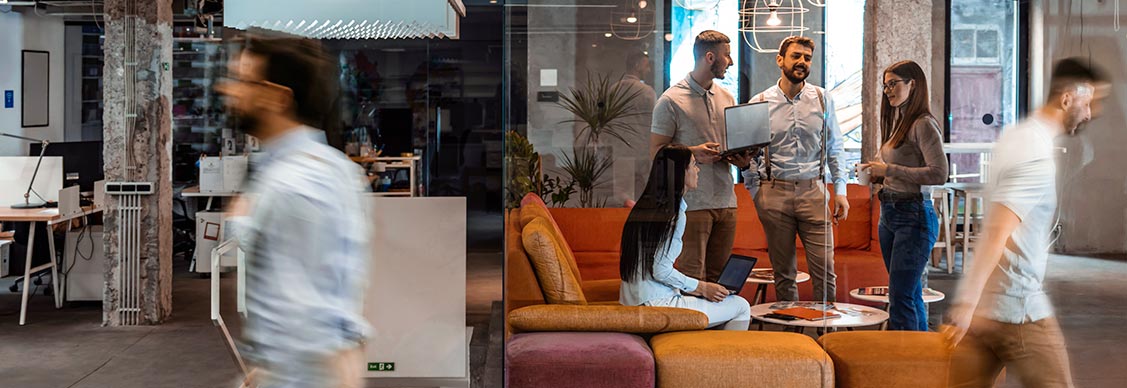Office life has changed. How are firms responding?
New data about how people work is driving changes in office design
In the ongoing struggle to get people back into the office, companies are trying to figure out how people are actually using spaces.
Tracking badge swipes when people arrive at work isn’t good enough.
“Think about it: a person can occupy several places simultaneously,” says Sam Lavers, Principal Growth and Alliances partner at JLL. “You have to consider they may book a meeting room, leave their belongings on a desk, all while having a spontaneous catch up with a colleague in a breakout area.”
This is the challenge facing corporate leaders who want to increase productivity and collaboration in an office setting: it’s hard to know what people are doing during the day. The time that individual seats or spaces are occupied – the so-called utilization rate - remains on average 25% lower worldwide than the 75% target, according to JLL’s occupancy benchmarking report.
Yet demand for less traditional workstations like quiet work areas, and an increased use of collaboration spaces, is making overall utilization tracking increasingly difficult to manage.
If leadership can better understand what types of spaces are being used – which in turn highlights different work styles and employee preferences – they can focus on creating an office that suits the needs of their people.
“Getting the balance between rightsizing and creating purposeful workplace experiences that spur people to come in, is more important than ever,” says Lilly Toncheva, Senior Director of Consulting in JLL’s Work Dynamics business.
AI provides greater occupancy insights
Technology is at the centre of the effort to understand what’s needed.
To make sure offices are redesigned to suit new, more agile ways of working, firms are starting to use advanced sensor technologies such as VergeSense, which can distinguish between people and objects, and AI platforms that help identify less obvious workflows to create models predicting what’s needed.
“It allows organizations to be more proactive rather than reactive, when it comes to managing their space,” says Toncheva.
Combining live occupancy – such as two people sitting on a sofa, with passive occupancy, like a handbag left on a desk – creates more sophisticated “occupancy intelligence.”
Lavers believes in the future it will become even more nuanced.
“The next step will be to pull in big data sources, analyzing how things like the weather, traffic, or the cafeteria special promotion impact occupancy and use,” he says.
Toncheva suggests that to capitalize on intelligence, firms should incorporate more flexibility into office designs. “Leases dictate that space is fixed, but demand fluctuates. Flexible solutions make it easier to quickly adapt layouts based on new insights,” she says.
Quality experiences drive utilization
While tech is key, data only provides half the picture. There are qualitative drivers like employee experience, satisfaction and individual work habits.
“We ask clients what they hope to achieve by getting employees into the office and then figure out what it will take to make that happen,” Toncheva says.
Take one JLL client, which felt their product innovation, creativity and speed to market was lacking due to remote work.
“We built a robust understanding of employee needs and preferences, mapped that against business requirements and team adjacencies, then created a series of personas,” says Toncheva. “It helped us redesign the space to support product workflows while also offering the comfort and experience that people craved.
Meeting needs
Meeting rooms remain a hot commodity. From availability to size and tech, there’s just not enough of the right type of room.
“The data we’ve seen reveals an imbalance between the size of meeting spaces and actual needs,” says Lavers.
Individual booths for calls, or smaller rooms for two to four people, are in high demand for hybrid meetings. But employees are finding the experience less than ideal.
“Historically tech investment went into bigger conference rooms, but today, most meetings have a mix of online and in-person participants,” says Toncheva. “These larger capacity rooms are now vastly under occupied the majority of the time.”
It means complaints about availability, and people just not showing up, are rising.
One solution is to integrate data from workplace sensors with booking software so rooms that remain empty in the first few minutes can be released. This can boost availability by more than 30%.
As technology continues to deliver new insights on more dynamic office behaviour, companies are starting to get a better handle on their future space requirements.
“It’s helping firms plan and prioritize workplace improvements that add value and drive utilization, with decisions based on data, not instinct,” concludes Lavers.
Explore more of JLL's latest insights on World Economic Forum themes at our dedicated Davos page.
